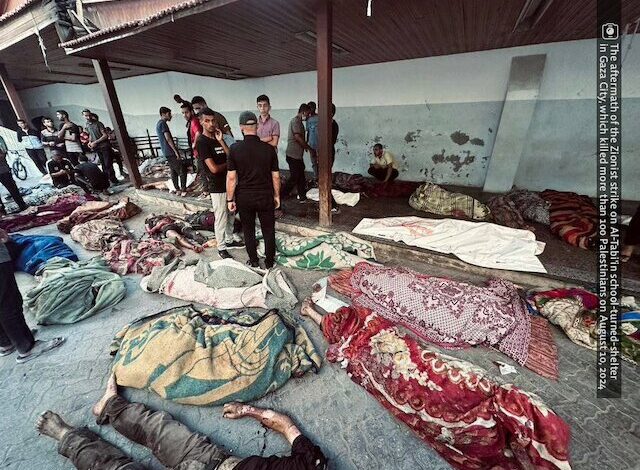The end of Dahiya Doctrine: ‘Gaza Doctrine’ and a new level in crime

Ali A. Jenabzadeh, researcher, journalist, and translator
Before the current war in Gaza, the “Dahiya Doctrine” was considered the most brutal and savage tactic used by the occupying Zionist regime. The primary goal of this doctrine was to instil fear in the hearts of anyone considering resistance against the regime. Developed by Israeli General Gadi Eisenkot, the doctrine dictates that in asymmetric urban warfare, the military deliberately targets civilian infrastructure to increase the suffering of civilians, thereby boosting deterrence. The Zionist regime first applied this doctrine during the 33-day war against Lebanon in 2006. However, the recent atrocities committed by the Zionists in Gaza has fundamentally changed this perspective. The Dahiya Doctrine can no longer be seen as the most severe method used by the Israeli army in broad daylight. The events of October 7 and their aftermath have altered the situation permanently.
The failure of the deterrence concept within the occupied territories led the Zionist regime’s decision-makers to make a series of strategic and critical errors, trapping them in a cycle of irrational decisions. In their first attempt to restore lost deterrence, the regime adopted a strategy aimed at maximizing civilian casualties. Supported without reservation by the West, especially by its main accomplice, the US, and unconcerned about the potential repercussions of this strategy, it increased civilian casualties through various methods. The core of this strategy is similar to the Dahiya Doctrine: it involves applying maximum pressure on the civilian population in the conflict zone, particularly through high civilian casualties, to increase social and psychological pressure on the opposing military or paramilitary forces until they surrender and give up the armed resistance. Although other tactics are used alongside this approach, the main goal remains to increase civilian casualties.
The latest example of this strategy was the brutal attack by the Zionist regime on areas it had previously labelled as “safe zones.” The latest image of this criminal behaviour is that of torn bodies of Palestinian children, piled in the schoolyard of Al-Tabi’in School in northern Gaza. Zionists brutally massacred more than a hundred Palestinians, most of them children, in an attack on this school which was previously declared to be “safe.” This attack was the latest in a series of attacks on schools that sheltered displaced people; Zionists attacked 9 schools previously labelled as safe, in less than 10 days. This new strategy could be called the “Gaza Doctrine.” Like the Dahiya Doctrine and other tactics used by the Israeli army against Palestinians, this strategy is illegal and constitutes a war crime. One could spend months or even years discussing the concept and implementation of “safe zones” under international law. Many books could be written about the illegality of this and other actions by the Zionist regime according to accepted international norms. While international law could be thoroughly examined and used to condemn Israel, the problem is that without a global consensus and with ongoing support from countries like the US and various European and non-European nations, international law remains largely ineffective.
Therefore, it might be time to move past the usual discussions of war crimes by the Zionist regime and address the world from different angles, confronting the ongoing threat of the regime’s survival and its ideology—an ideology succinctly captured by one of its own members in the book title: “Rise and Kill First!” This unchecked, ambitious, and aggressive mindset, which we refer to as “Zionism,” finds its existence in the destruction of others and broadly defines who these “others” are. This ideology rejects the possibility of peaceful coexistence and has no geographical limits on its ambitions, meaning even its current allies might become enemies in its view. Due to its ideological nature, this mindset does not consider anyone—human or otherwise—as its equal. To it, “others” are divided into two categories: enemies and “temporary” friends. Enemies are viewed as “human-like” beings that must be eliminated, as far as the world allows. Temporary friends are safe as long as they do not oppose the ideology’s interests. However, this has exceptions; for example, Israel, embodying this ideology, has even attacked its most significant “temporary friend,” the US, as seen on June 8, 1967, when the Israeli military attacked the USS Liberty, killing 34 US Navy personnel and wounding 171.
When this epitome of psychopathy is threatened, it unleashes such destruction that the world stands in stunned silence, watching. For instance, it gathers civilians in an area it has labeled as “safe,” meaning it has claimed and guaranteed the security of that area, and then attacks them with bombs and shells, hoping to restore its damaged deterrence and recreate a shadow of its former self. A precise description of the Zionist regime’s criminal behaviour was given by Imam Khamenei on July 28, 2024, saying that, “The Zionist regime is presenting and showing itself in the most grotesque image of a criminal gang. They’re not a government. They’re a gang of criminals. They’re a gang of murderers. They’re a gang of terrorists. In their acts of terrorism, cruelty, and crime, they’ve reached a new level in their shocking crimes in the history of human criminality in the world.” However, it is crucial for the world to recognize that the spread of Zionist ideology will not be limited to Palestine, Palestinians, or the Western Asia region. A regime that has used tactics and strategies like the Dahiya Doctrine and the Gaza Doctrine from the outset, and has avoided facing the consequences, will inevitably set new benchmarks for criminal behavior, as it has already done. This presents a global threat to humanity. As Imam Khamenei stated on July 28, 2024, It is clear and essential that “The world must make a more serious decision in response to this tragedy. Governments, nations, intellectuals, and political figures in various fields must truly come to a decision.”
(The views expressed in this article are author’s own and do not necessarily reflect those of Khamenei.ir.)
| © | KHAMENEI.IR |


